Abstract
The failure mechanisms in tension and fatigue of three Al alloys reinforced with ceramic particulates were studied by means of optical and scanning electron microscopy. Damage was concentrated in the reinforcements, which failed in a brittle fashion during deformation, leading to the specimen fracture when a critical fraction of broken particulates was reached in a given section of the specimen. This critical fraction was measured on polished longitudinal sections of broken specimens for each composite, temper, and loading condition, and was mainly dependent on the matrix alloy. It was also found that the reinforcement fracture probability was controlled by the particulate size and aspect ratio: large and elongated particulates oriented in the loading direction were more prone to fail than small, equiaxed ones. Finally, a significant fraction of the reinforcements in the cast materials was broken prior to testing. They were shattered during extrusion rather than fractured, and associated with clusters of particulates formed during solidification.
Similar content being viewed by others
References
R. H. Van Stone, T. B. Cox, J. R. Low andJ. A. Psioda,Inter. Metals Rev. 30 (1985) 157.
J. P. Tanaka, C. A. Pampillo andJ. R. Low, in “Review of developments in plane strain fracture toughness testing”, ASTM STP 463 (American Society for Testing and Materials, Philadelphia, 1970) p. 191.
D. Broek, “A Study on Ductile Fracture”, Report NRC-TR71021U, Delft, National Aerospace Laboratory (1971).
R. H. Van Stone, R. H. Merchant andJ. R. Low, in “Fatigue and fracture toughness: cryogenic behaviour”, ASTM STP 556 (American Society for Testing and Materials, Philadelphia 1975) p. 93.
D. J. Lloyd,Int. Mater. Rev. 39 (1994) 1.
Idem, Acta Metall. Mater. 39 (1991) 59.
Y. Brechet, J. D. Embury, S. Tao andL. Luo,Acta Metall. Mater. 39 (1991) 1781.
P. M. Mummery, B. Derby andC. B. Scruby,ibid.,41 (1993) 1431.
J. Llorca, A. Martin, J. Ruiz andM. Elices,Metall. Trans. 24A (1993) 1575.
P. M. Singh andJ. J. Lewandowski,ibid. 24A (1993) 2531.
J. Yang, C. Cady, M. S. Hu, F. Zok, R. Mehrabian andA. G. Evans,Acta Metall. Mater. 38 (1990) 2613.
T. Christman, A. Needleman andS. Suresh,Acta Metall. 37 (1989) 3029.
J. Llorca, A. Needleman andS. Suresh,Acta Metall. Mater. 39 (1991) 2317.
P. F. Thomason, “Ductile fracture of metals” (Pergamon Press, Oxford, 1990).
T. Lin, A. G. Evans andR. O. Ritchie,Metall. Trans. 18A (1987) 641.
K. Wallin, T. Saario andK. Törrönen,Int. J. Fracture 32 (1987) 201.
T. Mochida, M. Taya andD. J. Lloyd,Mater. Trans. JIM 32 (1991) 931.
Author information
Authors and Affiliations
Rights and permissions
About this article
Cite this article
Poza, P., Llorca, J. A study of the failure mechanisms in Al/Al2O3 and Al/SiC composites through quantitative microscopy. J Mater Sci 30, 6075–6082 (1995). https://doi.org/10.1007/BF01151530
Received:
Accepted:
Issue Date:
DOI: https://doi.org/10.1007/BF01151530




